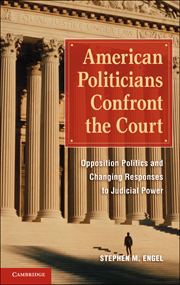 American Politicians Confront the Court
American Politicians Confront the Court Published online by Cambridge University Press: 05 June 2012
Many accounts of federal judicial politics during the Progressive era – the 1890s through 1930s – note how Republican hold on the Senate and presidency allowed near total control over judicial appointments. Candidates were vetted for “their devotion to party principles and ‘soundness’ on major economic questions of the day.” Judges protected corporate interests against state and federal regulation of workplace conditions, wages, and hours. Judges gave constitutional interpretation a Republican cast, shorthanded by the economic doctrine of laissez-faire and its legal counterpart, liberty of contract.
Federal courts are thereby depicted as countermajoritarian. By resisting popular support for workplace and wage regulation, rulings fomented anti-judge hostility that culminated in Franklin Roosevelt's seemingly Jeffersonian attack in 1937, that is, his proposal to stack the Supreme Court and enlarge the lower federal judiciary to prevent judicial nullification of New Deal policy. The failure to pass various Progressive measures, including FDR's Court-packing proposal, are understood to be evidence of popular and elite acceptance of judicial independence if not outright supremacy.
This chapter challenges this account by focusing attention on assessments of whether, how, and why Progressive proposals failed. Progressives took an inconsistent stance toward federal judicial authority. While some offered the most virulent anti-Court rhetoric since the Jeffersonian years, Progressives proved unable to construct a single solution to the problem of legitimate judicial authority. This failure stemmed from a muddled tradition drawing on incongruent Jeffersonian and Lincolnian strands of Republicanism.
To save this book to your Kindle, first ensure no-reply@cambridge.org is added to your Approved Personal Document E-mail List under your Personal Document Settings on the Manage Your Content and Devices page of your Amazon account. Then enter the ‘name’ part of your Kindle email address below. Find out more about saving to your Kindle.
Note you can select to save to either the @free.kindle.com or @kindle.com variations. ‘@free.kindle.com’ emails are free but can only be saved to your device when it is connected to wi-fi. ‘@kindle.com’ emails can be delivered even when you are not connected to wi-fi, but note that service fees apply.
Find out more about the Kindle Personal Document Service.
To save content items to your account, please confirm that you agree to abide by our usage policies. If this is the first time you use this feature, you will be asked to authorise Cambridge Core to connect with your account. Find out more about saving content to Dropbox.
To save content items to your account, please confirm that you agree to abide by our usage policies. If this is the first time you use this feature, you will be asked to authorise Cambridge Core to connect with your account. Find out more about saving content to Google Drive.